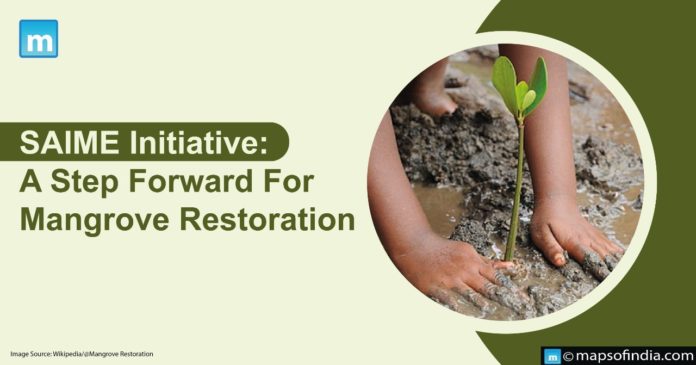The Sustainable Aquaculture In Mangrove Ecosystem (SAIME) initiative is a step taken by farmers to restore mangrove cultivation. There is growing hope for the development of Sundarbans through sustainable shrimp cultivation in the area. For several years, unsustainable aquaculture was the focus of environmentalists who pointed out their concern about cleaning mangrove forests for shrimp collection. Now under the SAIME initiative, the farmers have come forward to do their parts to restore the mangroves while doing cultivation of shrimp.
The SAIME initiative was started in 2019, and sustainable shrimp cultivation is being conceived by NGOs- Global Nature Fund and Nature Environment and Wildlife Society. Bangladesh Environment and Development Society. As mentioned in The Hindu, Dinobandhu Das, a shrimp farmer, said, “Our previous generation has cleared mangrove forests and cultivated shrimps. Under this initiative, we are planting mangrove trees around the shrimp ponds.” Shrimp cultivation is practised in a unique ecosystem of India and is one of the key occupations of the people residing in Sundarbans.
Mangrove Forests
Mangrove forests, also known as mangrove swamps, mangals, or mangrove thickets, occur in coastal intertidal zones. They are productive wetlands that grow mainly in tropical and sub-tropical latitudes. Mangrove forests live between the ocean, the land, and the atmosphere, which functions as a centre for the flow of matter and energy from one system to another. Mangrove forest reduces soil erosion caused by currents, waves, surges, and tides. Plants of these forests have dense prop roots, also known as breathing roots, with numerous pores through which the plants breathe. The presence of these roots allows the trees to slow down tides’ movement and hence settle down the mud in the water.
Mangrove forests attract fishes and other animals, which live in this habitat seeking food and shelter from predators. Mangals, unlike other forests, feature only a few tree species. Although the forest lacks tree species and has only three to four of them, it also does not lack diversity. The ecosystem created by these forests provides habitat to many species.
Sundarbans
The Mangrove area in India can be found in West Bengal. The Sundarbans is in the delta formed by the confluence of the Brahmaputra, Meghna, and Padma rivers in the Bay of Bengal. Sundarban is a long stretch between Bangladesh and India. It spans from the Baleswar river of Bangladesh to the Hoogly River in India. Being home to the world’s largest mangrove forest area, its protected areas are enlisted in the UNESCO World Heritage Sites.
Sundarbans’ largest available tree species are Sundari (Heritiera fomes) and gewa (Excoecaria agallocha). The Sundarbans are threatened by natural and human-made disasters, even though a commitment to its protection is made. It is seen that there is a consistent pattern of depletion and loss of biodiversity in the area. There is a ban on capturing or killing wildlife other than a few invertebrates and some fishes, then also the ecological quality of the forest is declining.




